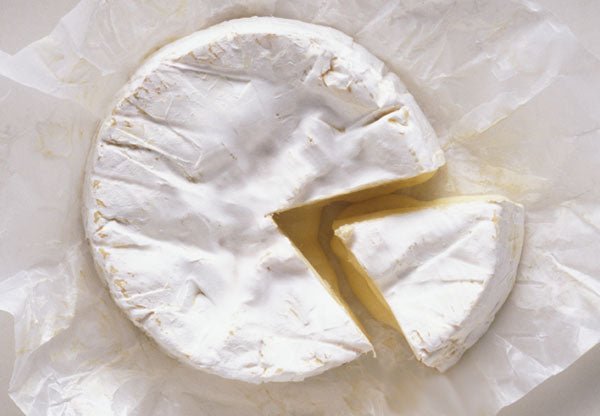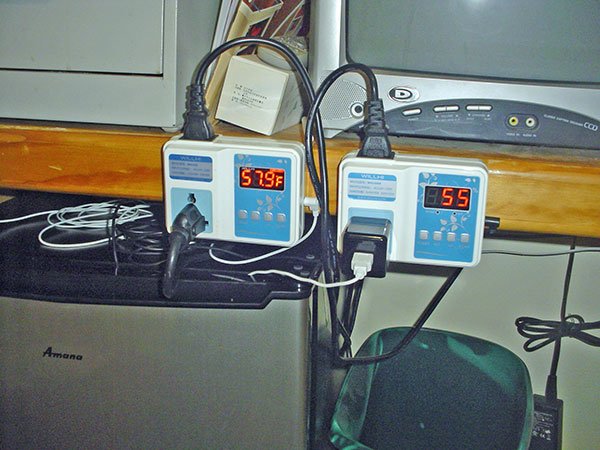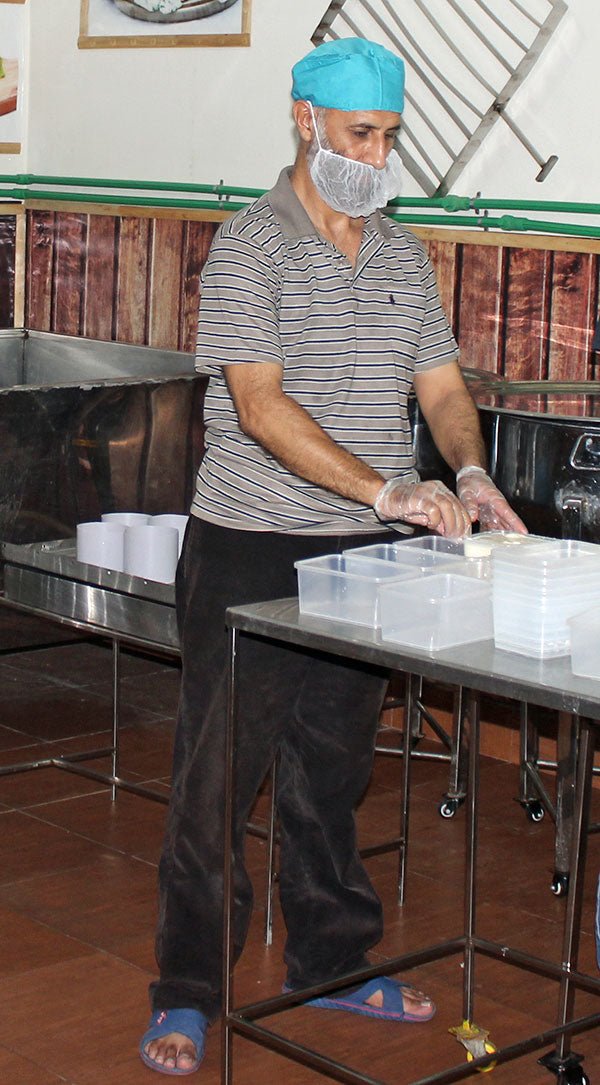
Take a deep breath! We know how it is…
That’s why we have a technical advisor on our staff to answer all your questions – just send them to info@cheesemaking.com and we’ll get right back to you. Feel better?
Of course, sometimes you don’t even know you have a question until you check out issues like the ones below:
While in the Molds

Sticking to the mats:
Q. Why did my cheeses stick to the mats when I tried to turn them on the first day?
A. You might have been turning the cheeses too early before the curds could dehydrate and knit to form a skin. In the future, wait longer before turning. It’s also possible that your curds were too moist. Be sure you have a “clean break” and stir the curds a little longer in the pot before you transfer them to your molds. If you didn’t cut the curds, do it next time.
Taking out of the molds

Slouching:
Q. After I took them out of the molds, they were sagging in the middle and they formed a barrel shape on the bottom.
A. The cheeses were still too moist/not sufficiently drained of whey when you removed the hoop support. Next time, drain longer (an extra 1/2-1 day at room temperature).
Blooming

Bright blue spots:
Q. My cheeses had bright blue spots all over them like someone had dribbled food coloring all over them. It didn’t look like mold and it smelled fine, but the white mold didn’t develop.
A. It might be that your salt had been contaminated with iron. Check to see if your salt was stored in a metal container or if your cheese was in contact with metal during the draining process.
Not so bright blue spots:
Q. It looked like spots of blue mold on my cheeses.
A. They were probably contaminated by the presence of blue cheeses. Those cheeses have to be kept away from your Cams.
Pink spots:
Q. My Camembert developed pink spots on the surface.
A. This was probably caused by too much moisture in the cheeses. Chances are the P. candidum eventually overpowered it, but next time, stir your curds longer before ladling them into the molds and let them drain longer before putting them in the ripening box. It may have also been caused by too much humidity in the ripening box. Be sure to wipe it down regularly.
Late development of white mold:
Q. White mold did not develop on my cheeses in the normal 12-14 days after making.
A. It’s most likely that the temperature was too low. If you had to bloom your cheeses in the refrigerator, it would have naturally taken longer for the mold to develop. You could try using a cooler to ripen your cheeses, as discussed in Part 2 (click here).
Uneven development of white mold:
Q. There were places with no mold growth on my cheeses.
A. It’s possible that you salted them unevenly or there might have been a draft in your ripening area. Assuming you dry-salted, you could try brining your cheeses next time.
No development of white mold:
Q. My cheeses never did bloom with the white mold.
A. There could be several reasons for this, so check this list and clarify the problem with our technical advisor (info@cheesemaking.com) before making it again.
- There wasn’t enough air circulating beneath the cheeses or perhaps the cheeses were sitting in the whey which had drained out of them.
- There was not enough humidity in your ripening box. (Sometimes you have to add a little moisture to the box to keep the humidity at 90-95%.)
- There was uneven (too much or too little) salting of the surface of the cheese.
- There were antibiotics in your milk.
- Your P. candidum had aged out or become contaminated.
Sticking to mats when turning:
Q. When I tried to turn my cheeses, the mold had grown into the mats.
A. This wouldn’t necessarily be a problem if it wasn’t so darned hard to clean the mats after! Next time, turn your cheeses more often (once/day is good) and use a coarser weave mat. Also, be sure there is good air circulation beneath your cheeses.
Orange bands on the rind:
Q. One of my cheeses developed faint orange bands on the rind.
A. If the cheese was too moist, other ambient molds may have moved in, causing a tan to orangish surface. Next time, drain longer before and/or after salting. If you think you did that for long enough, try stirring your curds for a longer time in the pot before transferring them to your molds.
Black fuzzy mold:
Q. In my last batch, I had an ‘infestation’ of black fuzzy mold popping up on my cams and it proliferated very quickly.
A. This could have been a form of mucor. In France they call it poil de chat or hair of the cat. If it was indeed “cat’s hair,” you might have been able to cut it off, but you might have had to throw away your cheese. We hope you didn’t eat it! It probably happened because the cheese was either too moist or it was not salted enough. The mucor could also have come from the environment or from too little air exchange in the ripening box. Also, if your milk was over 3 days old, so be sure to use fresh milk next time.
Toad skin (wrinkly, thick rind):
Q. Why did my cheese look like brain matter?
A. This is probably from excessive Geotrichum. If you used the specified amount, leave it out next time. It could also be from too much salt, too high a ripening temperature or too much moisture left in the curds after air-drying.
The Final Ripening

Ammonia smell:
Q. My cheeses smelled of ammonia by the end of their ripening time.
A. These cheeses may have become overripe too fast. The aging temperature might have been too high, or the cheeses were too moist. If the temperature was below 55F, next time, make sure to stir the curds longer before you ladle them into your molds and drain them a little longer. It’s also possible that the cheeses were not wrapped as soon as they became covered with mold. Be sure not to let the P. candidum grow excessively. Another possibility is that they were under-salted.
Ready to eat (or not!)

Too runny and sour smell:
Q. My cheeses were gooey and runny but I wanted them to be firmer.
A. This could be because your cheeses were overripe. Next time, try taking them out of your cave when they aren’t quite so soft. Or, the over-ripening could have been caused by too much moisture in your cheeses. Next time, try stirring the curds longer before you ladle them into the hoops and drain them a little longer than you did before. It is also possible that your cave was too warm (over 55F) or that your cheeses were under-salted. Check to see if you used too much Geotrichum, because that could also cause this. It’s rare, but sometimes the problem is in the milk with competing strains of yeasts and molds. If you suspect this, try pasteurizing the milk next time. If it was Spring when you made your cheeses, it’s also possible that the milk was low in casein because the animals changed their diet from winter fodder to grass.
Too firm:
Q. My cheeses never oozed the way I wanted them to.
A. This could be because you didn’t age them long enough. They should feel soft in the center when you take them out of your cave. Or, this could be caused by too little moisture in your cheeses. Next time, try stirring the curds for less time before you ladle them into the hoops and drain them for a slightly shorter time than you did before. There is also a remote chance that your P. candidum had aged out and become inactive. It’s also possible that there was too much fat in the milk (did you add cream?) or that your cheese wrap didn’t work properly.
Tastes bitter:
Q. My cheeses had a bitter taste.
A. This is probably because they were overripe. (See the “Ammonia Smell” section above). It may also be due to excessive starter culture, rennet or calcium chloride or to an imbalance with the P. candidum and Geotrichum. If you opted out of using Geotrichum, add it in next time because it can help with this.
Skin slipped off:
Q. My cheeses were firm in the middle, but the surface was gooey and the skin slid off.
A. This was probably caused by the cheeses being too moist. The mold began developing before the cheeses were dried sufficiently. Next time, be sure to wait until the curd has set long enough for a “clean break,” stir the curds a little longer before ladling them into your pot and drain them a little longer before/after salting.
Cheese became puffy and there were holes in the paste:
Q. My cheese looked like it had blown up in areas and there were holes all through it.
A. Excess moisture in the cheese caused it to become contaminated with Coliform bacteria or Candida. Throw out the cheese and next time, use different milk or pasteurize your milk and take steps to keep the moisture level lower in the curds – make sure to stir the curds longer before you ladle them into your molds and drain them a little longer in the molds.
Final Note:
If you have a question, please e-mail it to us at info@cheesemaking.com. If we think it’s a good question to share, we will add it to this article. If you want to share your own triumphs over adversity, please use the comments section below.















































































































































